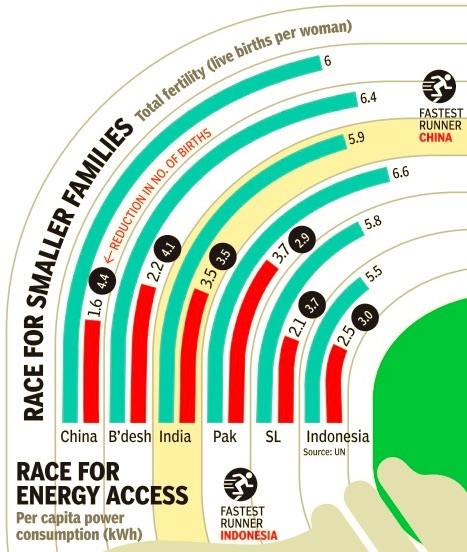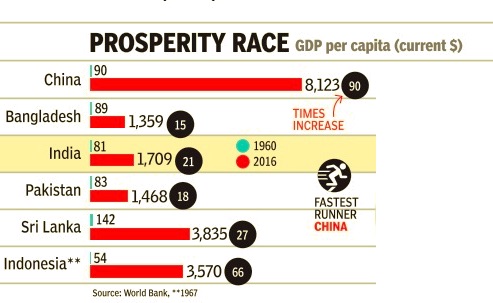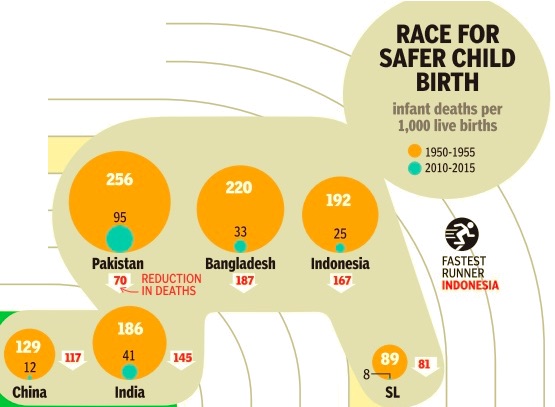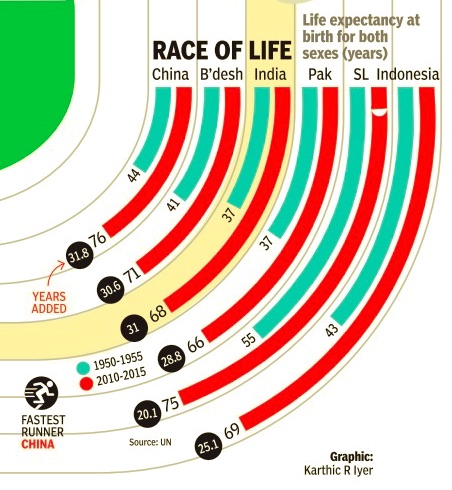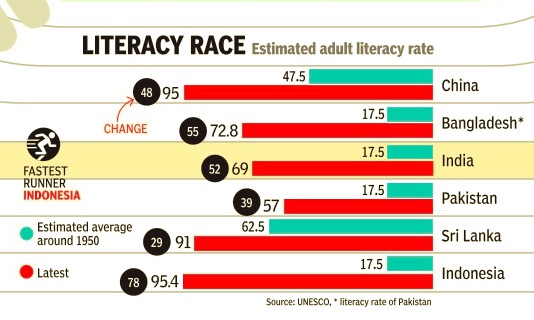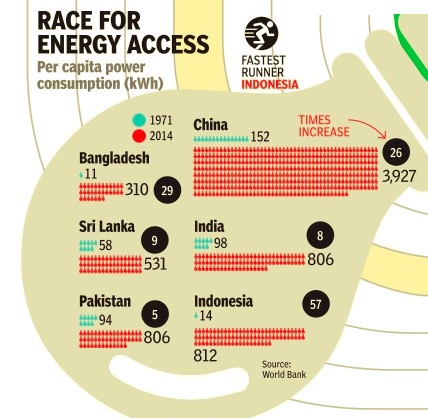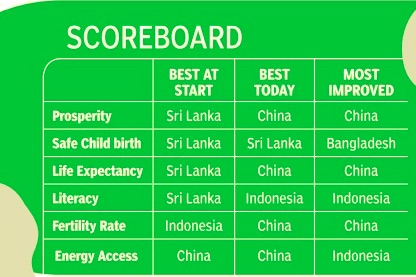India, A brief history: 1947 onwards






This is a collection of articles archived for the excellence of their content. |
1947: Partition; the first cabinets
See graphic: State of two then newly independent nations, India and Pakistan, as on August 15, 1947
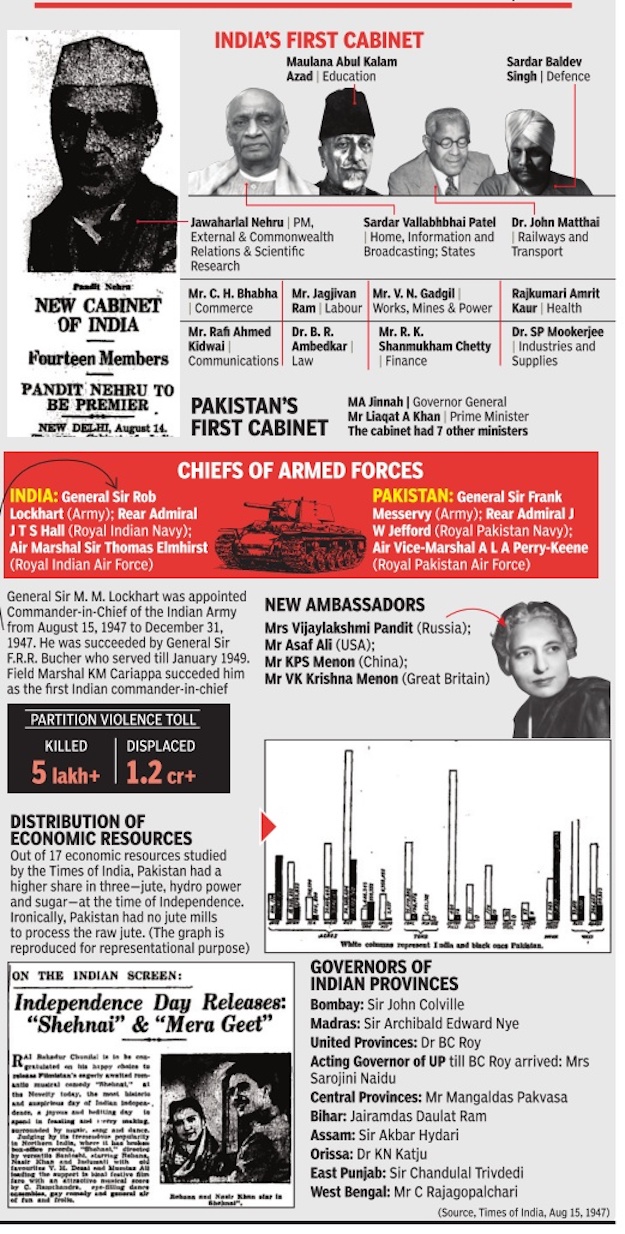
1947-67: a history of the early years
INDIA: AN UNAUTHORISED BIOGRAPHY PEOPLE, EVENTS, POLICIES, Aug 15 2017: The Times of India
1 Words to live by
Among the 20th century's stirring speeches is Nehru's `Tryst with Destiny' address to the Constituent Assembly at midnight, August 14, 1947, marking the transition to freedom. Laying out the vision for free India in 820 words, India's first PM talked of peace and service, foregrounding the themes of welfare and security in public discourse.
2 The Constitution's architect
A radical thinker rarely in agreement with Gandhians and Congress, B R Ambedkar was still appointed law minister in Nehru's first cabinet and tasked with raising a framework for modern India. He chose to underpin it with the principles of equality and justice, placing emphasis on individual rights rather than traditions, communities, and ideology. The idea of a strong Centre within a federal system of governance were also underscored through his arguments.A rare photo of Dr Ambedkar after his conversion to Buddhism
3 Bhasha battles
The language question loomed large much before states were reorganised on linguistic lines.
From the 1930s, Periyar opposed Rajaji's efforts to popularise Hindi in Tamil Nadu (Madras Presidency), and later DMK turned the stir into a movement that swept them to power.
4 India's heroes
Raj-Dilip-Dev: The troika that lorded over Bombay cinema and the nation's heart in the 1950s-60s. Dilip Kumar typified bottled, moody passion; Dev Anand was the urbane, debonair male; Raj Kapoor, the heart-of-gold, Chaplinesque hero in Nehruvian movies with songs (Awara hoon, Mera joota hai Japani) that became timeless anthems.
DID YOU KNOW?
Raj & Dilip acted together in Andaz. Dilip & Dev were lead performers in Insaniyat. Raj & Dev never shared the same screen space.
5 Song of the road
Pather Panchali, Satyajit Ray's lyrical debut feature (1955), put India on the map of world cinema and became the benchmark for every aspiring Indian auteur.
6 Road maps
India had 12 five-year plans for the economy since 1951.Although scrapped in favour of Niti Aayog's three-year action plans, the USSR-inspired plans are the reason one can drive from Kashmir to Kanyakumari without starving on the way.
7 Rise of the Reds
In 1957, the first-ever elected communist government was formed in Kerala with EMS becoming the chief minister. Invoking Article 356, PM Nehru dismissed the EMS govt in 1959, after it initiated radical land reforms and an overhaul of the education system.
8 Temples of modern India
Massive hydel projects (Bhakra Nangal, Hirakud) built in the 1950s-60s became emblems of Nehruvian development.
They set the stage for the Green Revolution but lost their sheen by the 1990s, and activists campaigned actively against them.Picture of Hirakud Dam on a Rs 100 note
9 At war
The Indian Army, its reputation burnished by WWII, was handed a morale-wrecking defeat in the Himalayas by China's PLA which came with overwhelming numbers and superior firepower.The Army's prestige was crushed, as was Nehru's spirit.
10 Peasants, workers unite
The summer of '67 uprising by peasants and tea garden workers in the picture-postcard north Bengal village of Naxalbari created the template for armed, radical Left movements that continue to thrive in swathes of India Ignored.Busts of Lenin, Stalin, Mao and Charu Mazumdar in Naxalbari
1947-64: the building of institutions
I
See graphic:Hectic campaigning in Delhi before the first general election and The 1950s Balance Sheet
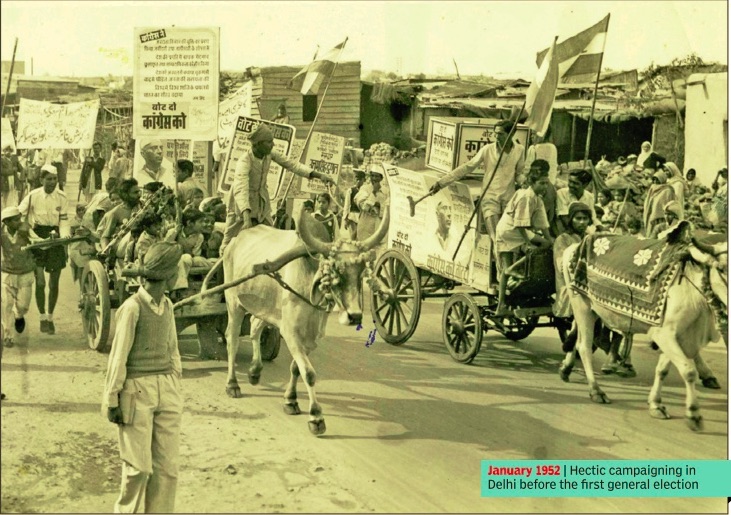
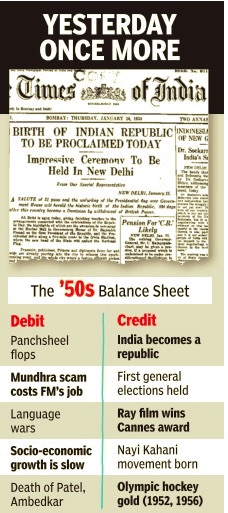
A decade of nation-building under Jawaharlal Nehru provided an industrial base, a pool of scientific talent, and a legal frame for wide swathe of reforms
The first two decades after Independence belonged to Jawaharlal Nehru. He epito mised India's gigantic effort to become modern, self-re liant and remain together. There were many detractors of these efforts for they were sure that a country so divided by language and religion, racked by ancient prejudices and as poor as some of the poorest in the world, had no chance to survive.
Yet, miraculously, India survived and slowly fears of its disintegration reced slowly fears of its disintegration receded. It is not as if there were no anxious moments. Maharashtra wanted a state of its own and, before it, so did the Telu gu speaking people of the erstwhile state of Madras.The government dithered on this in the fear that this was the beginning of the dreaded Balkanisation threat that they were warned against.
However, as the States Reorganisa tion Commission finally resolved these demands it became clear that neither the newly-formed Andhra Pradesh, nor Maharashtra had any intention of separating from India. The ethos of the National Movement was stronger than what some of their leaders gave it credit for. What is more, it established the legitimacy of a state being governed in its own language -a provision that Sri Lanka, for example, failed to provide and suffered as a consequence.
What helped resolve many of these early difficulties was the fact that India had crafted a Constitution which became ef fective in 1950 and is regarded, even today , as one of the leading liberal documents of the democratic world. It established basic rights and liberties and also de-legitimised some of the ancient practices among Hindus which were unfair to women and debased many on the basis of caste.
This was a social revolution at one stroke. Doubtless, there were many leading figures who were by Nehru's side in this endeavour, Dr Ambedkar, principally , but it was Nehru's political acumen and legislative skills that eventually saw these provisions as law. He simultaneously moved against landlordism and this invited a strong backlash from entrenched quarters, but Nehru won the day .
There were other irons in the fire as well. Nehru initiated an entirely innovative economic policy that was clearly not communist or blatantly capitalist. He believed that a mixed economy was the best way for India to overcome the initial difficulties of becoming a modern industrial state.
He pushed for a strong public sector which would provide steel, energy and heavy equipment and establish the basis for sustained economic entrepreneurship in the years to come. Though the public sector is in much disrepute today, it can hardly be doubted that the infrastructural impetus that Nehru started allowed for a modern economy to develop.
All economies need knowledge, high ly skilled and technical at that, to keep them humming. There is little doubt that if India can boast of being a hub in today's information technology sector, or of producing world-class engineers and of a high-powered scientific body, it is Nehru who deserves the credit. He had the wisdom and foresight to set up the Indian Institute of Science, the IITs, the AIIMS and the IIMs, to name a few.
Alongside, in the field of culture, the Lalit Kala Akademi and Sangeet Kala Akademi and the Film and Television Institute of India were also established at his insistence. It was an all-out, four square thrust to bring India into the modern world of knowledge, sciences and the arts. Such was the vision of the man.
In foreign policy, Nehru's contribution was not nearly as singular and suf fered several setbacks, some of them during his lifetime. Both the USSR and the US were suspicious of the Non-Aligned Movement. The former thought we were being manipulated by the communists and Stalin believed that this was just a thinly disguised US plot. The India-China War of 1962 robbed all of the starch in the Non-Aligned Movement and the India-China 1952 Panchsheel Policy .
When Nehru died, he was a vastly disappointed man not just because his personal charisma had suffered a massive erosion with the 1962 China War, but also because his hopes that the public sector would man the commanding heights of the economy was not getting anywhere fast.
But, by then India was a stable, democratic republic and the fear that it would collapse was belied. Nehru showed his critics that those who ran the government were not people of straw, as often accused. Truly, this was nation building as good as one can get, for which reason that period can justifiably be called the Nehruvian years.
II
See graphic:The 1960s Balance Sheet
The building of a great edifice needs a head who enjoys intellectual, administrative and financial freedom. And he, or she, must also be young enough to have the time to succeed In social sciences, there is a rich literature on institutions, institu tional behaviour and the way insti tutions shape society, especially for relatively formal institutions like the legislature, executive and judiciary, civil society, media, business, science, technology, education and health. In debates about the legacy of British colonial rule in India, institutions figure. The pride of India's democracy isn't about elections alone, it is also about these institutions.
For the Union government, we have been told there are at least 679 autonomous bodies. These, too, belong to the category “institution“. There are others at the state level, and we mustn't forget institutions associ ated with local bodies. When we talk about “institutionbuilding“, more often than not we have in mind the Union government, less so the state and local governments.Nor do we have in mind institutions that evolve independent of govern ment, though given government's visible and invisible presence, both malign and benign, no institution in the ecosystem can afford to completely ignore government.
Ask yourself this: Why is it important for any event organised by such an institution to have government representation at inaugural or valedictory functions? Conceptually , there can be three kinds of institutions -those part of government or extended government, those ostensibly autonomous (but largely , if not entirely, funded by government), and those independent. Let's take ostensibly autonomous ones first. Even if you cannot name all 679, and this is irrespective of specific legislation under which they were set up, name a few prominent institutions, ones that, in your view, have left an imprint.
I am reasonably certain the antecedents of those prominent post-Independence institutions go back to the 1950s and 1960s, not beyond, not yet. What explains this vintage, and what has gone wrong since then? Some principles should be truisms, but aren't always appreciated. First, every individual doesn't have it in him or her to build an institution. In the narrow economics domain, there have been few like V K R V Rao.
A good academic resume doesn't necessarily make for a good institution-builder. That requires a different skill set. Second, those who select people to head institutions must possess the foresight to recognise those skill sets and recognise them sufficiently early. Back then, in that different day and age when gerontocracy and seniority didn't determine rules, peo ple were chosen as heads of institutions in their 40s, even early 40s. Notwithstanding increases in life expectancy , a person chosen as head at 58 has little time to build. Nor does that person have a stake in the future of the institution. Third, and this follows from the second, the person chosen must be given freedom, intellectual, administrative and financial, and a sufficiently long tenure.
The collapse of the third principle is almost certainly the main reason why the vintages of successful institutions are the 1950s and 1960s. Within government and extended government, the '70s was the decade when institutions, the bureaucracy and the judiciary had to be “committed“.
The steel frame rusted and the judiciary was also corroded. When there was supersession (think of the judiciary), it was based on commitment, not merit. Add to that the carrot of postretirement sinecures. For the steel frame, which is part of government, dissent has a limited role and is perforce constrained. However, for the broader ecosystem of autonomous institutions, dissent is desirable. Dissent and debate are part of democracy's discourse and require conscious nurturing for institutions to thrive and prosper. This brings me to the last principle, the lack of which, I think has been the bane.Fourth, the political leadership (there is no need to use the word government any more) has to possess confidence, an appetite for risk-taking, and have democracy in its DNA.
If you choose someone young, there is a risk you take. If you allow intellectual ferment and debate, there is a risk you take. True, the First Amendment to the Constitution curbed absolute freedom of speech and expression as early as 1951.
Nevertheless, curbing is not identical to control. Otherwise, like the Model T, there can be numerous institutions, but their colour will be identical.
1969-1975
INDIA: AN UNAUTHORISED BIOGRAPHY PEOPLE, EVENTS, POLICIES, August 15, 2017: The Times of India
11 Rajdhani on track
India's first superfast, fully air-conditioned train, Rajdhani Express, charged out of New Delhi in 1969, and musafirs developed a taste for complimentary meals. Train travel was no longer only about getting somewhere; it was also about the journey.
12 Cricket wins abroad
Two series Test wins abroad in 1971 by captain Ajit Wadekar's merry men, against the formidable Sobers-led West Indies (1-0) and the respectable Illingworth-managed England (1-0), raised the profile of cricket in India like never before.
13 Tiger, tiger burning bright
Project Tiger India's flagship conservation project began in 1973 when tigers were in decline, their number guesstimated at 1,800.
Despite setbacks that saw their number drop to 1,411 in 2006, the project has achieved a modest turnaround.
14 Military might
The only decisive war India ever fought, 1971 saw India flex both military and diplomatic muscle successfully and establish itself as a regional power. Bangladesh was born as was the icon named Indira.
15 Going nuclear
India joined the nuclear club with an underground explosion in Pokhran, Rajasthan, on May 18, 1974. Codenamed Smiling Buddha, the tests caused global consternation, but it upgraded India's status as a military power. Pokhran II happened in May 1998.
'16 Land of milk (not honey)
India's journey to become the world's leading milk producer parallels the life of Verghese Kurien, a mechanical engineer-turned-dairy-expert. He created a grid of milk cooperatives that remains the prototype for agri initiatives.
17 Green is the colour of revolution
From the 1960s, the government promoted use of high-yield seeds, chemical fertilisers and irrigation to improve foodgrain production and achieve self-sufficiency in food.
18 Darkest days of democracy
To browbeat the Opposition, Indira Gandhi declared the Emergency on June 25, 1975. Opposition leaders were jailed, civil liberties curbed, the press gagged and many forcibly sterilised in the next 21 months. In the election that followed the Congress was routed and the Janata Party swept to power.
19 Chipko movement
The act of 27 Garhwali women hugging trees to stop them from being felled in 1974 became a stencil for non-violent resistance for people's control over natural resources.
Led by Sunderlal Bahuguna, the Chipko movement inspired several environmental movements, including the Narmada anti-dam agitation.
The 1980s
INDIA: AN UNAUTHORISED BIOGRAPHY PEOPLE, EVENTS, POLICIES, August 15, 2017: The Times of India
See graphics:
Change in preference of vehicle from scooters to motorcycles, 1998-99
The 1980s Balance Sheet
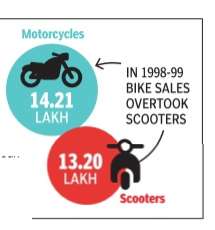
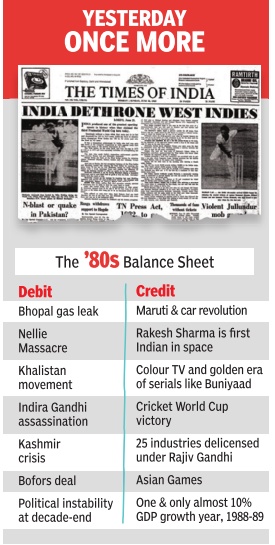
20 The power of 100cc
The dream of owning a vehicle became a reality for many in 1980 when manufacture of 100cc motorcycles was allowed. Riding on Japanese technology, affordable bikes flooded the market and changed commuting experience.
21 Friends, family, VCR
Binge-watching predates the internet. It dawned in the 1980s with VCRs (video cassette recorder) and tapes. Movie buffs, bored of DD's Sunday evening films, had the option of renting a VCR and three tapes from the neighbourhood `parlour' for an all-nighter. It was always a social event with friends and immediate neighbours invited.
22 When Punjab bled
Through the 1980s and early 1990s Punjab was a dangerous place where terror was cloaked in religion. The militants wanted Khalistan, a separate country for Sikhs. Their chief, Jarnail Singh Bhindranwale, was killed in Operation Blue Star (1984). Estimated casualties of civilians, terrorists and security forces between 1981 and 1992 were more than 21,000
23 Southern star power
NTR chose mythological roles while MGR donned a Robin Hood avatar.
NTR was a novice; MGR was an Annadurai admirer. Both became CMs. Neither cared for inner-party democracy; both swore by populist schemes.
Their cultivation of attire and manner and their autocratic style continue to inspire others.
24 Cricket, live on TV
India's most memorable sporting triumphs were heard on radio, seldom seen. But the unlikely 1983 triumph of Kapil's Devils over domineering Windies was watched live on TV and, later, on VCRs, across the country taking cricket to small-town and mofussil India like never before.
25 Bhopal gas tragedy
On the night of December 3-4, 1984, the world's worst industrial disaster killed 20,000 and injured 5.5 lakh people over the years. It forever changed the way industrial safety, compensation and litigation worked the world over.
26 OK, Tada, bye-bye
Tada was India's first anti-terrorism law (1985).
Some 76,000 people were arrested under Tada, 35% of the cases were brought to trial, and only 2% were convicted. Allowed to lapse in 1995 due to rampant misuse, it became the template for subsequent draconian laws like Pota (2002-04) and the amended Unlawful Activities (Prevention) Act.
27 Scam & scandal
Bofors, the Swedish gun, has served India well against enemies, but its first casualty was the credibility of the Rajiv Gandhi government. Allegations of kickbacks Rs 64 crore -stuck, and corruption became an election plank in the 1989 elections that Rajiv's Congress party lost. While India entered a long coalition era, `scam' and `scandal' became part of our street lexicon.
28 Assassination and after
The storming of Sikhism's holiest shrine, Harmandir Sahib, during Operation Blue Star galled the Sikhs, and just five months later, on October 31, 1984, PM Indira Gandhi's Sikh bodyguards Satwant Singh and Beant Singh shot her from point-blank range at her New Delhi residence. After that, Sikhs were targeted by mobs across northern states and thousands were killed.
29 People's car arrives
Conceived by Sanjay Gandhi to rival the Ambassador and Fiat, Maruti added wheels to the middle-class dream in the 1980s. Powered by an 800cc engine, it became the people's car that everyone aspired for. The Indo-Japanese company still commands over 50% of marketshare in automobiles.
1970
WAS WHEN A COMPANY NAMED SURYA RAM MARUTI TECHNICAL SERVICES PRIVATE LIMITED (MTSPL) WAS STARTED TO PROVIDE TECHNICAL KNOW HOW FOR THE DESIGN, MANUFACTURE AND ASSEMBLY OF “A WHOLLY INDIGENOUS MOTOR CAR“
The 1980s- early 1990s
INDIA: AN UNAUTHORISED BIOGRAPHY PEOPLE, EVENTS, POLICIES, August 15, 2017: The Times of India
30 BINARY BOOST
Barring specialists in scientific institutions, computers meant little to anyone in the early '80s. But Rajiv Gan dhi, pilot by training, stressed on tech-telecom missions to give engineering R&D and education a boost in the midst of a US embargo. India's IT majors and the start up ecosystem were catalysed in this soup.
31 Babri Masjid is pulled down
The Ramjanmabhoomi movement led by the Hindutva brigade climaxed with the demolition of a medieval mosque in Ayodhya on December 6, 1992.
Riots followed, the worst being in India's commercial heart Mumbai. For some, the event challenged the idea of Nehru's India.
32 LOAN AGAINST GOLD
Through the second half of the 1980's, India battled a foreign currency shortage. By the end of the decade, it was on the verge of defaulting on payments for imports: it had just enough foreign exchange to cover three weeks of imports. The situation forced RBI to raise a loan of $405 million by pledging its gold reserves and physically transferring it to London. The news focused attention on the crisis in the Indian economy.
33 REAL ECONOMIC INDEPENDENCE
In the backdrop of an economic crisis, India was reinvented with finance minister Manmohan Singh's milestone budget (PM PV Narasimha Rao, 1991) and P Chidambaram's dream budget (PM HD Deve Gowda, 1997) to open up new areas for private sector participation and reduce bureaucratic controls on them. It led to India's most economically vibrant period with an eightfold increase over 25 years in the economy's size and catalysed social change.
34 Big Bull Mehta
Harshad Mehta was the original `Big Bull', whose flashy lifestyle in pre-billionaire India attracted many to the stock market in search of easy money. Mehta's scam in the 1990s exposed loopholes in the system and expedited the move to transform Sebi into a statutory body. Was finally caught for evasion of income tax
35 MUMBAI ROCKED
A chain of explosions rocked Mumbai in the aftermath of the Babri demolition, set off by a gang executing orders from India's Most Wanted, Dawood Ibrahim.
The death toll was 257 and 713 were injured. The attack, the deadliest on an Indian city, left a deep impact on Mumbai's psyche and led to an unending criminal trial.
36 Enter the suicide bomber
Rajiv Gandhi as PM tried to stem ethnic conflicts, but mediation in Sri Lanka and sending troops to enforce peace turned the LTTE against him. A brutal, secessionist outfit which until then had used Tamil Nadu as a safe haven, it put a suicide bomber at a rally he addressed. Congress did rebound, but a vacuum remained.
37 CABLE, CNN AND SOAP OPERAS
Cable TV broke Doordarshan's monopoly of eyeballs in the early '90s when private channels brought Bold and Beautiful, WWF, CNN (first Gulf war) and other emblems of Americana to our homes. The idea of entertainment transformed, spawning lifestyle and lingo shifts. Now, with data becoming cheap, TV viewing seems set for another tectonic shift.
38 INDIA GETS MANDALISED
In pre-liberalisation India, government jobs were the middle-class's mainstay. And Prime Minister VP Singh's decision to implement the decade-old Mandal Commission Report which extended caste-based reservations to OBCs riled millions.
Following the self-immolation of DU student Rajeev Goswami, violent protests engulfed north India. But VP's move turned out to be a permanent political gamechanger.
The 1980s planted the seeds of the 1990s
Social Upheavals Like Mandal Built Into An Unstoppable Storm For Change
When stories need to be told about the past, it is de rigueur to seek seminal events and turning points on which to hang the nar rative. Thus, it is commonplace to believe that Indian economic history was rewritten when Manmohan Singh liberalised the economy in 1991; that the BJP's political edifice was built on the ruins of the Babri Masjid in 1992; that Pokharan II saw India emerge as a nu clear power; that the dotcom boom of the late 1990s saw India's rise as an IT superpower; that the anti-corruption movement began with Anna Hazare and Arvind Kejriwal.
In short, the Nineties and the Noughties were the happening decades, with the Eighties being the dark era, bringing only bad memories of the licence-permit raj, failed reforms, riots, mob violence, ethnic cleansing, assassinations, corruption and caste conflict. tion and caste conflict.
Hindsight allows us to question history from a vantage point. The glorious Nineties would not have been glorious without the Excruciating Eighties, which should be seen as a defining decade in India's history.
A cascade of political and economic events and halting reforms defined the Eighties. The prelude to the decade saw Indian voters writing off the Janata Party experiment as a bad dream, but the idea of a non-Congress government stayed with us and resulted in the Atal Behari Vajpayee government of 1998-2004. And Modi in 2014.
The first seeds of economic liberalisation were sown in the 1980s, when Indira Gandhi romped back to power. Her government started the process of unwinding the licence-raj by adopting the policy of “broadbanding“, which meant companies producing more than what they were licensed to were not penalised. After her assassination, her son Rajiv Gandhi pursued this policy further, and 25 industries were delicenced in March 1985. India saw the creation of its first home-made modern car (the Maruti), built on the ruins of Sanjay Gandhi's failed dream of doing the same. Flashy mobikes replaced the stodgy scooters. Rajiv Gandhi brought the Asiad to India, and with it came TV , creating the basis for the wider dissemination of news and entertainment in a democracy; this expansion of the discourse from the classes to the masses is what helped foment a million mutinies in India, preparing the ground for the emergence of a new aspirational class that demanded more and expected more.In 1988-89, India saw its only-ever double-digit growth rate, but it was built on the sand of dubious fiscal policy, setting the stage for external bankruptcy and a forced change of economic course in 1991 under Narasimha Rao and Manmohan Singh.
We underrate the Eighties because it brings us horrific memories of a violent Khalistan movement and the anti-Sikh riots of 1984, the Nellie massacre and the Assam agitation against illegal Bangladeshi immigrants, and the ethnic cleansing of Pandits from the Kashmir Valley . But Indira's assassination in October 1984, and Rajiv's sination in October 1984, and Rajiv's in 1991, marked the beginning of the end of two major terrorist movements in Punjab and Sri Lanka, though this was punctuated by two policy mistakes Indira's assault on the Golden Temple to flush out terrorists, and Rajiv's attempt to send the Indian Army to rein in the LTTE. Rajiv's election in 1984 saw the end of the Punjab and Assam agitations, and no one can take this achievement away from him.
But he failed to change the system. Nothing illustrated this better than Bofors, where bribes were paid to middlemen in the purchase of this Swedish howitzer, with Rajiv himself suspected to be involved. While India was not new to corruption and scandals, Bofors shook India like never before. Not only did it upend the Rajiv Gandhi government, but the anti-corruption sentiment that brought VP Singh to power in 1989 created the template for future political movements that used an anti-corruption plank to come to power. Echoes of that storm are still reverberating in India, with Modi riding to power using the UPA-era corruption scandals as pegs to mount his campaign on. If the first anti-corruption movement the one led by Jayaprakash Narayan in the early 1970s ended in Indira Gandhi imposing the Emergency, the latest one, started by Anna Hazare, has given anti-corruption more legs to stand on; Narendra Modi has demonstrated that there may even be electoral gains to be made after putting people through hardships with the demonetisation of high-value notes.
The social upheavals of the Eighties also contributed to the remaking of India. If the first few decades of independence, which were marked by the building of the “temples of modern India“ large state sector steel plants, the IITs, the IIMs created India's upper caste-led middle class, the Mandal movement demanding caste-based reservations for non-SCST groups broadbased the middle class; from a handful, the middle class soon grew to several hundred million in just over two decades.
It is sometimes said that Mandal led to the Mandir agitation, which finally led to the rise of Hindutva politics and the razing of the Babri Masjid in 1992. But the more insightful way of looking at Mandalisation is that it created a broader Hindu platform for the growth of the BJP . The BJP post-Mandal became broadbased in its social composition, and today its leading light is a man from the “other backward castes“.It is no longer a Brahmin-Bania party , as the very adoption of the goods and services tax (GST) shows. A trader-led party would have opposed GST tooth and nail. With this, the BJP is now a broad centrist party , with Hindutva leanings, but one which the responsibility of power will soften.
Put simply, the Eighties were when the demand for change began to build into an unstoppable storm. We can regret the violence and communalism that accompanied this transition, but we can't wish away the fact that what grew into a giant tree was the sapling planted, unwittingly or wittingly, in the Eighties; what remains an ugly sore on the conscience of the nation, began as a small itch in that decade.
The 1990s
INDIA: AN UNAUTHORISED BIOGRAPHY PEOPLE, EVENTS, POLICIES, August 15, 2017: The Times of India
39 THE POLL GURU
The 10th chief election commission er, TN Seshan (1990-96), changed Indian elections forever. Despite political resistance he implemented laws for codes of conduct, election expenses, use of propaganda mate rial, etc. Under him, the Election Commission finally acquired its independence.
40 RISE OF THE DALITS
Dalits, or Harijans as they were generally referred to, were considered to be part of the Congress `vote bank' till Kanshi Ram and his associate Mayawati welded them into a self-aware political grouping, transfiguring north Indian politics.
41 DIAL A REVOLUTION
Under Rajiv Gandhi, telephone and STD booths mushroomed. Telecom revolution 2.0 got underway in 1995 when West Bengal's Leftist chief minister Jyoti Basu made the first call on a mobile phone, the ultimate status symbol then. A minute's call (Rs 24) cost as much as a litre of petrol. Today calls are almost free and rickshaw pullers could own a cellphone, even a smartphone. Telecom subscribers number over a billion. Only one thing is lost: privacy.
1 CALL'S COST IN 1995 24 ( 16 for calling, 8 for receiving) TODAY CALLS ARE ALMOST FREE
42 FIRST FAMILY OF BUSINESS
Despite charges of crony capital ism, Dhirubhai Ambani built one of the world's most powerful businesses from a 350-sq-ft room in Masjid Bunder. In less than two decades he built India's largest private company. Son Mukesh is now the richest man in India, with a net worth of over Rs 3 lakh crore on April 2017.
43 ALT-CINEMA
The parallel cinema movement began in the late 1960s but flourished in the 1970s and 1980s, nurtured by the likes of Shyam Benegal and Govind Nihalani, and actors Om Puri, Naseeruddin Shah, Smita Patil and Shabana Azmi.
Together they provided an alternative to mainstream Bollywood. Southern cinema saw a resurgence through the works of Adoor Gopalakrishnan, G Aravindan and Girish Kasaravalli.
44 ROY THE TRENDSETTER
Arundhati Roy's The God of Small Things won the Booker Prize in 1997. A literary and commercial success, it opened up avenues for Indian authors writing in English and started the era of big book advances in the country. It also gave India its best known political activist and voice of conscience.
45 KARGIL WAR
Though a low-intensity conflict, Kargil 1999 was a stab in India's back at a time when it was trying to make a new beginning with Pakistan after the Lahore declaration between Prime Minister Atal Bihari Vajpayee and his Pakistan counterpart Nawaz Sharif . Himalayan heights lost had to be recaptured at a great cost of men and material.
46 ROLE MODEL FOR PERFECTION
Sachin Tendulkar blended insatiable run-making with impeccable off-field conduct to become India's most marketable and first multi-million-dollar cricketer.
1994-2000
INDIA: AN UNAUTHORISED BIOGRAPHY PEOPLE, EVENTS, POLICIES, August 15, 2017: The Times of India
47 Malls and Multiplexes
The new temples of new India, over 500 malls and 2,200 multiplex screens have combined to revolutionise the way urban and small-town India shops and entertains itself.
48 CROWNING GLORIES
The year was 1994 and a popular model with gorgeous grey-green eyes was billed as the favourite to win Miss India. Not only did the little-known 18-year-old Sushmita Sen steal the national pageant, she went on to win Miss Universe.Aishwarya Rai had to console herself with the Miss World title.Others who brought home titles were Diana Hayden, Lara Dutta, and Priyanka Chopra, among others. These pageant victories inspired millions of girls, both in cosmopolitan as well as smalltown India, to work out for that model bod. And it spawned the multi-million-rupee beauty industry across the country. Getting the story right 52 Critics panned Chetan Bhagat for his tacky turn of phrase, but he wrote and spoke the lingo of the young, urban, aspirational Indian. His paperbacks, priced at Rs 99 a piece, became bestsellers, and birthed the sub-genre of Indian easy-read fiction in English.Bhagat is now university course material, proving today's India is full of possibilities.
49 Clean air on order
Goaded by the Supreme Court's 1998 ruling, Delhi's public transport network of buses switched from diesel to cleaner, cheaper CNG, helping curtail pollution and prevent hundreds of premature deaths due to respiratory ailments. The landmark order paved the way for other cities to follow a similar path. But its impact was soon negated by an exponential rise in the population of cars and two-wheelers running on diesel. Eighteen years later, the SC revisited the issue in 2016 as smog enveloped the city. Public transport expansion seems the only way out.
50 No-ball and out
If cricket is religion in India, then match-fixing is the ultimate sin. In 2000, Delhi Police took the lid off what was cricket's worst kept secret. Among those who had to face the music were top cricketers such as captain Mohd Azharuddin, Ajay Sharma and Ajay Jadeja.
None of them were charged but they never played for India again.
51 Malta boat tragedy
The drowning of over 300 South Asians, 170 of them Indians, on Dec 25-26, 1996, was the worst loss of life in the Mediterranean since World War II. It awakened the world to the problem of illegal migration.Thousands more have died since. The journeys of death continue.
52 It worked for UPA
Poverty alleviation schemes come and go but UPA's 2006 MGNREGA scheme had that magical phrase “guaranteed 100 days income“ which captured the hinterland's imagination and helped Manmohan Singh's government win another term.
53 The Three Khans
Salman, Shah Rukh and Aamir -three of a kind -have grown bigger and better with every passing decade. Together they have ensured that Bollywood stays healthy and flourishes globally despite piracy and the Hollywood invasion. Of late, though, the charisma seems to be waning.Salman's Tubelight and Shah Rukh's When Harry Met Sejal have hardly set the box-office on fire. Only Aamir's Dangal ruled both India and China.
54 Big B's lifeline
Kaun Banega Crorepati (2000), India's most expensive quiz show, turned the fortunes of Star TV and recast a sliding Amitabh Bachchan as superstar of the small screen. The show triggered a bunch of failed imitators and altered the idea of prime time entertainment.
The post- 1992 era of rapid growth
See graphic:
The 1990s Balance Sheet
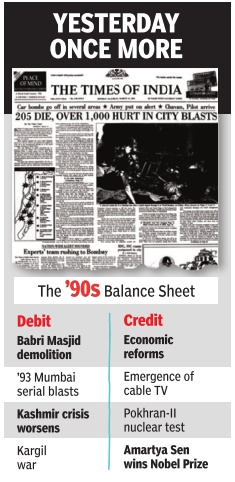
In the time of Sensex and Sushmita Sen, the economic reforms finally freed India from the Hindu rate of growth
Where business is without fear and the Sensex is held high Where the market is free Where the economy has not been broken up into fragments By narrow socialist ends Where industry comes out of the clutches of licence permit raj Where endless forms don't stretch their arms towards bribery Where the clear stream of enterprise has not lost its way Into the dreary desert sand of dead frustration Where innovation is led forward Into ever-rising growth and development Into that heaven of choices, my FM, let my country awake We had walked into Tagore's `heaven of freedom' eyes glistening, optimism held high and a fair and handsome Prime Minister who dressed Indian, spoke Oxonian and thought Fabian.But 40 years later, the poster child of the post-WWII world looked decidedly hollow eyed. The licence permit quota system had strangled private endeavour of every kind. The unaccountable nationalised sector turned out a product that was usually gross. Having waited five years to get a phone connection, we were shortchanged by an MTNL which stood for `Mera Telephone Nahin Lagta'. Shortages gave Henry Ford's famous offer a distinctively Indian accent: `You can have any product of your choice provided you pay for it in black.' Thus, we entered the 1990s with national bankruptcy putting a gun to our head, and the IMF yapping at our heels, threatening to stop all further bailouts. Surprisingly, the guys who so flamboyantly changed the game were two of the most soporific-seeming men ever in Indian polity. The languorous Prime Minister Narasimha Rao and his taciturn Finance Minister, Dr Manmohan Singh. The economic reforms of 1991-92 were a shotgun wedding, but from their consummation sprang the hitherto unknown consumer society . Bharat the commodity turned into India the brand, or at least one with the outer trappings thereof.
As the last decade of the 20th century swaggered ahead, we plunged bravely into the new world of transformation. Having lived with a scenario where the only choice was take it or leave it, we began baskin' in one where everything came in 21 flavours. The public sector tumbled from its `commanding heights' and the newly liberated private players rushed in where they had seldom been allowed to tread.This was most noticeable in the financial markets. Davids challenged the Goliath of the nationalised banks whose inefficiencies had been papered over by state protectionism. The best and the brightest became `high-wage' islands, with Pradeep Shah's name invoked in awe for having broken the one-croreper-annum barrier.
More to the point, while money had always talked, for the first time it became an unabashed talking point. The once discreet worship of Lakshmi turned into a clanging, clamorous aarti to the creation of wealth. Or to choose a more secular metaphor, making money came out of the closet and turned into a flaunt-it-all parade.
The spending of money underwent an even more dramatic change, physical and psychological. Socialism's pursedlipped disapproval gave way to a khullam khulla loosening of purse strings.Horror, we even learnt to splurge before we earned. The streetcar named desire glided smoothly on the hitherto unheard of tracks of plastic and EMI.
Economic reforms freed India from that endless cycle of dearth and redearth which had come to be known as the `Hindu rate of growth'. Nirvana was pegged to the GDP of globalisation, development and privatisation. This triumvirate ordered the overarching metamorphosis. If it often overreached, that too was okay, in fact a fundamental part of the no-hold-barred mandate. With the middle class becoming the first of the great spenders, India's image turned from begging bowl to market opportunity . Global fund managers arrived jangling bags of FII and FDI.
It would naturally follow that society too would drop its old burqa and paint its lips in strumpet red. True, the makeover was powered by the liberalised economy, but society added noticeable dare-to-bare of its own. The dreaded `P' form had discouraged anyone from going abroad since we were only allowed to take out a ridiculous $11 and involved grovelling for letters from NRI relatives undertaking to `sponsor' your holiday . As travel rules eased up along, they brought back fresh approaches to everything.
Especially food. Vast armies travelled on their stomach, and even if the `maharaj' became an important camp follower, the paneer-chomper learnt to savour parmesan and the rotiwallas developed a taste for Swiss rosti. Gujaratis were the most visible (and audible) Indian travellers despite the restraints of `Pure Veg' and purer `Jain'. Credit the metamorphosis of Ahmedabad as much to this as to its CM, Mr M. An all-American `soda fountain' called Chills, Frills Thrills spouted on its Gandhian streets, and `pasta bens' blithely brought up a generation which had never eaten the once-staple of dal-bhaat-shaak.
Reflecting, and leading, the change was what came to be labelled mediamorphosis.Doordarshan was thrown on the dust-heap of state monopolies, and viewers hitched their wagon to Star. Transponders became society's transformers. Global television inevitably began to impose its `footprint' on print. It was the dawning of the age of news as entertainment began; `content' would enter the lexicon more loudly with the arrival of the Internet. Dictatorial editors in ivory towers became as obsolete as the elephant hunt, and the `reader' began to be appeased as the `customer'. In this genuflection, the conventional `who, where, when, why and how' was extended to the way news was produced, disseminated and consumed.
The T-rex of technology made this possible like everything about the way we lived, worked and played. As in the Marxian view of capitalism, it too carried within itself the seeds of destruction. But none of this spoilt the party, nay not even the doomsday threat of Y2K, as we danced into the next millennium with fin de siecle abandon.
2000-2017
INDIA: AN UNAUTHORISED BIOGRAPHY PEOPLE, EVENTS, POLICIES, August 15, 2017: The Times of India
See graphic:
The 2000s Balance Sheet
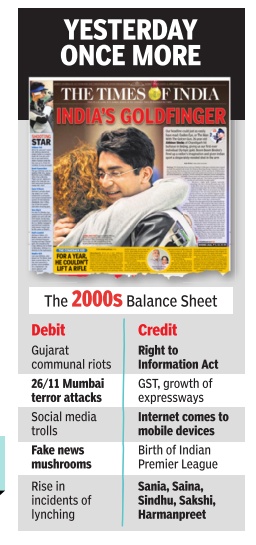
55 Twitterati and trolls
When Narendra Modi tweeted about his first meetings as PM, everyone sat up to open accounts. Twitter has said India is its fastest growing market for daily active users, growing 5x the global average this year. But armies of vicious trolls, abusive tweets and fake news show India has a long way to go to understand debate and cyber etiquette.
56 DAYS OF TERROR
Militants sent by boat from Karachi landed in Mumbai on November 26, 2008, got past layers of security and unleashed a bloodbath on the streets, in a hospital and railway station, cafes and hotels.
It went on for three days.
The toll touched 166 before all but one were killed. It was a wake up call for the police, military and intelligence agencies.
57 Demanding answers
Few laws have empowered ordinary people as The Right to Information Act, which yanked open the Steel Frame of India in 2005. Around 1.75 crore RTIs -4,800 a day -have been filed in the past decade. Many queries are stonewalled but in several cases, notably Mumbai's Adarsh Society scam, RTI shook the establishment. The question of transparency has reached the doors of the judiciary and political parties as well. So far the information commission's attempts to define them as “public authorities“ in a bid to make them disclose assets or their working style has been met with resistance. But many Supreme Court judges have sought to promote a climate of accountability by revealing how much they are worth.
58 Creating unicorns
Founded in 2007 by IIT graduates Sachin Bansal and Binny Bansal to sell books online, Flipkart not only changed the way India shopped but also showed the world that India was ready for tech entrepreneurs to build billion-dollar companies. With SoftBank investing $2.5 billion, FlipKart can now reach for the stars.
59 Out of Cash
On November 8, 2016, PM Narendra Modi launched India's third demonetisation drive, after 1946 and 1978, to flush out black money. It wiped out 86% of the currency in circulation overnight and caused serpentine queues outside ATMs and banks. After-effects included suffering agro markets, job losses, drop in real estate demand and -surprise, surprise -a sweeping victory for the BJP in the 2017 UP polls.
60 ANNA, ARVIND & AAP
Love it or loathe it but Arvind Kerjriwal's AAP is definitely the most exciting and original thing to happen in Indian politics.
In Feb 2015, they swept the Delhi state polls, leaving the BJP flabbergasted and its opponents in ecstasy. Many now wonder what happened to the party which emerged out of Anna Hazare's anti-corruption movement that electrified India in 2011.
61 The Duracell director
In a career spanning five decades, versatile director Yash Chopra delivered blockbusters such as Deewar, Kabhi Kabhie and Dil To Paagal Hai, effortlessly bending his craft to the mood of the time. His Yash Raj films, which has produced hits like DDLJ, the Dhoom series and Sultan, is one of the biggest banners in Bollywood.
62 Women power in sports
At the 2016 Rio Olympics, both medals for India were won by women: PV Sindhu (silver) in badminton and Sakshi Malik (bronze) in wrestling. They typify the leap women have made in sports -Karnam Malleswari (weightlifting), Sania Mirza (tennis), Saina Nehwal (badminton) and Mary Kom (boxing) -this millennium.
63 BABA AND BUSINESSMAN
Baba Ramdev's rise as India's chief yoga evangelist started 15 years ago with a TV show that was equal parts fitness and spirituality. Nobody foresaw that the saffron-clad Baba would transform into India's biggest FMCG phenomenon, challenging MNCs, and emerge a political player, mocking the epitaph some wrote after his escape from Ramlila Maidan in a woman's garb.
64 YES, PRIME MINISTER
Narendra Modi's charisma pulled India out of the mire of coalition politics after 25 years -his is the first non-Congress government to enjoy a majority in Lok Sabha -and his vote catching appeal only seems to grow despite controversial economic measures such as demonetisation.
2000-2017: technological changes
When technology gave faceless Indians a voice, everything began to change, faster.
But the very people to whom technology brought home the power of democracy now sanction the dismantling of its institutions
A BJP government was in power in 2000 and it is in power to day. Pakistan, terrorism and Kashmir were at the top of the national agenda then (the Kandahar hijacking had just taken place), and they continue to dominate the headlines today . And yet, the world we live in has undergone a fundamental change. If liberalisation in the '80s and '90s marked the arrival of a new era, with big changes in our mindsets and the way we lead our lives, post 2000, thanks to a combination of technology , media and the deeper penetration of the market mechanism, we have seen another big change. This is a New India, in all its connotations, make no mistake.
The events that mark the 17 years in question are many question are many and diverse -the Gujarat riots, 2611, the rise of Narendra Modi and the decimation of the Congress, swanky new airports and expressways, malls and mobile phones, the short-lived resurgence in a participatory form of democracy with the Anna Hazare movement and the RTI, the IPL and 100 (and now 1,000) crore blockbusters, selfies and Whatsapp, trolls and gau-rakshaks, demonetisation and GST -these are merely a few milestones on this journey.
What has brought about these changes is a combination of technology and media with the increasing penetration of not just the market, but the market as a mindset. At one level, this helps free up energies of a large group of people while dismantling the power of traditional elites. The mobile phone revolution has made everybody somebody; today aspirations have become an engine for change.The consuming class, in particular, has in this period started moving out of a constraint-driven worldview into a possibility powered one. The India of the 2000s is an India that has begun to acquire the sheen of prosperity , although so far this is only skin deep.
But market-mindedness has other effects, too. Individual desire becomes the basis of our actions; things are judged not by whether they are right or wrong, but by whether they are popular or not. The rise in a celebrity culture that is pervasive, and of a format like the IPL which uses a staid sport like cricket and repackages it dazzlingly , are part of this new interplay between media and the market.
One significant shift is in the not-sosubtle movement from journalism, the profession, to media, the business. The whole-hearted integration of journalism with business has made it a product that must deliver business outcomes. Media content is determined much more by what the audience wants, and this has led to a sea change in the nature and tonality of coverage. The second big change has been the advent of social media, which has converted every individual into a broadcaster. This has given voice to a vast number of people who were hitherto mere readers or viewers. The concerns of the mainstream have, therefore, taken centre-stage, and this has meant a dramatic change in what gets discussed as well as the language and manner in which these discussions take place.
Politics, too, has been transformed beyond recognition. If the '80s and '90s were about making democracy more representative, the 2000s have been about a more personal engagement with democracy; the gradual recasting of democracy as a consumer product. Politics today reflects the concerns of an increasingly vocal middle class. In the earlier part of this period, this took the form of a search for an alternative to conventional politics. The rise of the AAP and the radical use of the RTI were parts of this attempt, but these have been overshadowed and almost laid to rest by the rise of the BJP . The need for participation in the democratic process has been taken care of by the emergence of social media armies, where everyone gets to criticise and abuse the person and party of their choice. The new nature of politics in India was underlined by the manner in which the 2014 campaign was mounted. It followed a fundamentally different blueprint, focusing on creating a media-driven image for Modi using a combination of hard promise and shrewd metaphor.
New India is much more in touch with its desires and aspirations, without worrying too much about the ideals of an earlier time which are now being actively discredited. Democracy is legitimising the dismantling of democratic institutions.A new assertiveness is taking its place that finds expression in an overt display of nationalism. The fragmented and diffuse nature of diversity in India is being mobilised into a more unitary form; as a result, binaries of an ethno-religious kind are hardening.
Liberalisation, when it came, was feared for the destabilising changes it would bring in its wake. As it turned out, a lot of the fears did not quite translate into reality . It is only post 2000 that the full effects of a market orientation, when combined with new forms of media, are being felt. The result is an India that is in touch with -and striving to indulge in -all its desires, both uplifting and base.
Basic developmental indicators
See graphics:
Race for smaller families and energy access, Bangladesh, India, Pakistan and the world
Prosperity race, Bangladesh, India, Pakistan, Sri Lanka and the world
Race for safer child birth, Bangladesh, India, Pakistan and the world, 1950-2015
Race of life, Bangladesh, India, Pakistan, Sri Lanka and the world, 1950-2015
Literacy rate, Bangladesh, India, Pakistan, Sri Lanka and the world, 1950-latest as in August 2017
Race for energy access, Bangladesh, India, Pakistan, Sri Lanka and the world.jpg|Race for energy access, Bangladesh, India, Pakistan, Sri Lanka and the world
Scoreboard, prosperity, safe child birth, life expectancy, literacy, fertility rate, energy access
